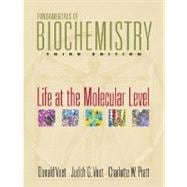
Note: Supplemental materials are not guaranteed with Rental or Used book purchases.
Purchase Benefits
What is included with this book?
Judith ("Judy") Voet received her B.S. in Chemistry from Antioch College and her Ph.D. in Biochemistry from Brandeis University with Robert H. Abeles. She has done postdoctoral research at the University of Pennsylvania, Haverford College, and the Fox Chase Cancer Center. Her main area of research involves enzyme reaction mechanisms and inhibition. She taught Biochemistry at the University of Delaware before moving to Swarthmore College. She taught there for 26 years, reaching the position of James H. Hammons Professor of Chemistry and Biochemistry before going on "permanent sabbatical leave." She has been a visiting scholar at Oxford University, University of California, San Diego, University of Pennsylvania, and the Weizmann Institute of Science, Israel. She is Co-Editor-in-Chief of the journal Biochemistry and Molecular Biology Education. She has been a member of the Education and Professional Development Committee of the American Society for Biochemistry and Molecular Biology as well as the Education Committee of the International Union of Biochemistry and Molecular Biology. Her hobbies include hiking, backpacking, scuba diving, and tap dancing.
Charlotte Pratt received her B.S. in Biology from the University of Notre Dame and her Ph.D. in Biochemistry from Duke University under the direction of Salvatore Pizzo. Although she originally intended to be a marine biologist, she discovered that Biochemistry offered the most compelling answers to many questions about biological structure-function relationships and the molecular basis for human health and disease. She conducted postdoctoral researching the Center for Thrombosis and Hemostasis at the University of North Carolina at Chapel Hill. She has taught at the University of Washington and currently teaches at Seattle Pacific University. In addition to working as an editor of several Biochemistry textbooks, she has co-authored Essential Biochemistry and previous editions of Fundamentals of Biochemistry.
| Introduction | |
| Introduction to the Chemistry of Life | |
| The Origin of Life | |
| Biological Molecules Arose from Inorganic Materials | |
| Complex Self-replicating Systems Evolved from Simple Molecules | |
| Cellular Architecture | |
| Cells Evolved to Carry Out Metabolic Reactions | |
| There Are Two Types of Cells: Prokaryotes and Eukaryotes | |
| Molecular Data Reveal Three Evolutionary Domains of Organisms | |
| Organisms Continue to Evolve | |
| Thermodynamics | |
| The First Law of Thermodynamics States that Energy Is Conserved | |
| The Second Law of Thermodynamics States that Entropy Tends to Increase | |
| The Free Energy Change Determines the Spontaneity of a Process | |
| Free Energy Changes Can Be Calculated from Equilibrium Concentrations | |
| Life Obeys the Laws of Thermodynamics | |
| Box 1-1 Pathways of Discovery | |
| Lynn Margulis and the Theory of Endosymbiosis | |
| Box 1-2 Perspectives in Biochemistry | |
| Biochemical Conventions | |
| Water | |
| Physical Properties of Water | |
| Water Is a Polar Molecule | |
| Hydrophilic Substances Dissolve in Water | |
| The Hydrophobic Effect Causes Nonpolar Substances to Aggregate in Water | |
| Water Moves by Osmosis and Solutes Move by Diffusion | |
| Chemical Properties of Water | |
| Water Ionizes to Form H + and OH a?? | |
| Acids and Bases Alter the pH | |
| Buffers Resist Changes in pH | |
| Box 2-1 Biochemistry in Health and Disease | |
| The Blood Buffering System | |
| Biomolecules | |
| Nucleotides, Nucleic Acids, and Genetic Information | |
| Nucleotides | |
| Introduction to Nucleic Acid Structure | |
| Nucleic Acids Are Polymers of Nucleotides | |
| The DNA Forms a Double Helix | |
| RNA Is a Single-Stranded Nucleic Acid | |
| Overview of Nucleic Acid Function | |
| DNA Carries Genetic Information | |
| Genes Direct Protein Synthesis | |
| Nucleic Acid Sequencing | |
| Restriction Endonucleases Cleave DNA at Specific Sequences | |
| Electrophoresis Separates Nucleic Acids According to Size | |
| DNA Is Sequenced by the Chain-Terminator Method A#1 | |
| Table of Contents provided by Publisher. All Rights Reserved. |
The New copy of this book will include any supplemental materials advertised. Please check the title of the book to determine if it should include any access cards, study guides, lab manuals, CDs, etc.
The Used, Rental and eBook copies of this book are not guaranteed to include any supplemental materials. Typically, only the book itself is included. This is true even if the title states it includes any access cards, study guides, lab manuals, CDs, etc.